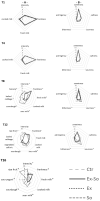Evolution of VOC and Sensory Characteristics of Stracciatella Cheese as Affected by Different Preservatives
- PMID: 33053809
- PMCID: PMC7601598
- DOI: 10.3390/foods9101446
Evolution of VOC and Sensory Characteristics of Stracciatella Cheese as Affected by Different Preservatives
Abstract
Undesired volatile organic compounds (VOCs) can negatively affect the flavor of fresh food products; especially those characterized by a mild and delicate aroma. Finding connections between chemical and sensory analyses is a useful way to better understand the arising of off-flavors. A study was conducted on stracciatella; a traditional Italian cream cheese that is emerging on international markets. Samples were prepared by adding two different preservatives (alone or combined): sorbic acid and an olive leaf extract. Their influence on flavor preservation during refrigerated storage was investigated by chemical, microbiological and sensory analyses. A strong change of the VOC profile was ascertained after 8 days in the control cheese and in the sample added with leaf extract alone. The samples containing sorbic acid, alone or in combination with leaf extract, gave the best chemical and sensory results, demonstrating a significant shelf-life extension. In particular, these samples had lower concentrations of undesired metabolites, such as organic acids and volatiles responsible for off-flavor, and received better scores for odor and taste. Ex and Ex-So samples had significantly higher antioxidant activity than Ctr and So throughout the entire storage period, and the color parameter shows no differences among samples taken on the same day. The use of the olive leaf extract, at the concentration tested, seemed to be interesting only in the presence of sorbic acid due to possible synergic effect that mainly acted against Enterobacteriaceae.
Keywords: cheese storage; natural preservatives; sensory characteristics; stracciatella cheese; volatile organic compounds.
Conflict of interest statement
The authors declare that they have no known competing financial interests or personal relationships that could have appeared to influence the work reported in this paper.
Figures







Similar articles
-
Analysis of Volatile Compounds in Processed Cream Cheese Models for the Prediction of "Fresh Cream" Aroma Perception.Molecules. 2023 Oct 23;28(20):7224. doi: 10.3390/molecules28207224. Molecules. 2023. PMID: 37894701 Free PMC article.
-
From milk to cheese: Evolution of flavor fingerprint of milk, cream, curd, whey, ricotta, scotta, and ripened cheese obtained during summer Alpine pasture.J Dairy Sci. 2018 May;101(5):3918-3934. doi: 10.3168/jds.2017-13573. Epub 2018 Feb 14. J Dairy Sci. 2018. PMID: 29454692
-
Short communication: Sensory characteristics and volatile organic compound profile of high-moisture mozzarella made by traditional and direct acidification technology.J Dairy Sci. 2020 Mar;103(3):2089-2097. doi: 10.3168/jds.2019-17059. Epub 2020 Jan 15. J Dairy Sci. 2020. PMID: 31954576
-
Natural Preservatives from Plant in Cheese Making.Animals (Basel). 2020 Apr 24;10(4):749. doi: 10.3390/ani10040749. Animals (Basel). 2020. PMID: 32344784 Free PMC article. Review.
-
Volatile flavor release from foods during eating.Crit Rev Food Sci Nutr. 1996 Dec;36(8):765-84. doi: 10.1080/10408399609527749. Crit Rev Food Sci Nutr. 1996. PMID: 8989509 Review.
Cited by
-
Legumes as basic ingredients in the production of dairy-free cheese alternatives: a review.J Sci Food Agric. 2022 Jan 15;102(1):8-18. doi: 10.1002/jsfa.11502. Epub 2021 Sep 9. J Sci Food Agric. 2022. PMID: 34453343 Free PMC article. Review.
-
Metabolomics Approach to Characterize Green Olive Leaf Extracts Classified Based on Variety and Season.Plants (Basel). 2022 Dec 1;11(23):3321. doi: 10.3390/plants11233321. Plants (Basel). 2022. PMID: 36501360 Free PMC article.
-
Physicochemical, Sensory and Nutritional Properties of Foods Affected by Processing and Storage.Foods. 2021 Dec 2;10(12):2970. doi: 10.3390/foods10122970. Foods. 2021. PMID: 34945521 Free PMC article.
-
Determination of the Variability of Biophenols and Mineral Nutrients in Olive Leaves with Respect to Cultivar, Collection Period and Geographical Location for Their Targeted and Well-Timed Exploitation.Plants (Basel). 2020 Nov 27;9(12):1667. doi: 10.3390/plants9121667. Plants (Basel). 2020. PMID: 33261197 Free PMC article.
-
Application of Commercial Biopreservation Starter in Combination with MAP for Shelf-Life Extension of Burrata Cheese.Foods. 2023 Apr 30;12(9):1867. doi: 10.3390/foods12091867. Foods. 2023. PMID: 37174405 Free PMC article.
References
-
- Djekic I., Miloradovic Z., Djekic S., Tomasevic I. Household food waste in Serbia—Attitudes, quantities and global warming potential. J. Clean. Prod. 2019;229:44–52. doi: 10.1016/j.jclepro.2019.04.400. - DOI
-
- Tylewicz U., Inchingolo R., Rodriguez-Estrada M.T. Food Aroma Compounds. Elsevier Inc.; Cambridge, MA, USA: 2017.
-
- Shahidi F. Indicators for evaluation of lipid oxidation and off-flavor development in food. Dev. Food Sci. 1998;40:55–68. doi: 10.1016/S0167-4501(98)80032-0. - DOI
Grants and funding
LinkOut - more resources
Full Text Sources

